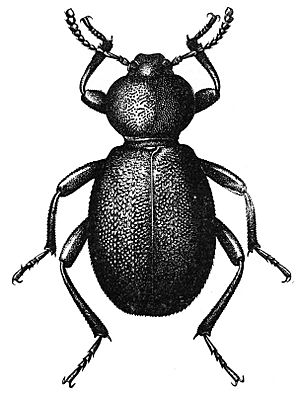Pinacate beetle facts for kids
Quick facts for kids Pinacate beetle |
|
|---|---|
 |
|
| An Eleodes pimelioides beetle. | |
| Scientific classification |
|
| Kingdom: | Animalia |
| Phylum: | Arthropoda |
| Class: | Insecta |
| Order: | Coleoptera |
| Family: | Tenebrionidae |
| Tribe: | Amphidorini |
| Genus: | Eleodes Eschscholtz, 1829 |
Eleodes is a group of beetles often called pinacate beetles or desert stink beetles. These interesting insects are found only in western North America, especially in the Sonoran Desert. The name pinacate comes from Mexican Spanish, which got it from the Nahuatl (Aztec) word pinacatl. This word simply means "black beetle."
Pinacate beetles are famous for a special way they protect themselves. When they feel threatened, they stand on their heads and squirt a bad-smelling spray. This unique defense has given them other nicknames like clown bug and stink bug, though these names are also used for other insects.
Contents
Pinacate Beetles: Masters of Defense
Pinacate beetles are a type of darkling beetles. They are known for their dark, hard bodies, which help them survive in dry places. These beetles are not harmful to humans, but their defense mechanism is quite memorable!
How They Defend Themselves
When a pinacate beetle feels scared, maybe by a bird or a lizard, it quickly stands on its head. This unusual pose is a warning. If the predator doesn't leave, the beetle will then squirt a stinky liquid from its rear end. This spray is harmless but smells very bad, making most animals lose their appetite for a beetle snack!
The Stinky Spray
The spray contains chemicals called quinones. These chemicals are irritating and have a strong, unpleasant smell. This is why the beetles are sometimes called "stink bugs." The spray is a very effective way to tell predators to stay away without hurting them.
Where Pinacate Beetles Live
These beetles are found across the western parts of North America. Many different kinds of pinacate beetles live in the Sonoran Desert, which covers parts of Arizona, California, and Mexico. They are well-adapted to living in dry, desert environments. You might spot them walking slowly across the sand or under rocks.
See also
- Pinacates para niños (Information about pinacate beetles for kids in Spanish)

